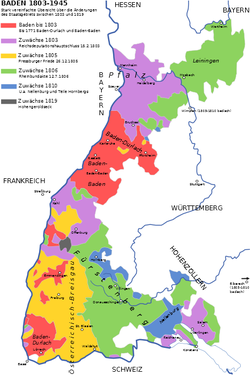
Back Markgrafschaft Baden ALS Marca de Baden AN مرغريفية بادن Arabic Margraviatu de Baden AST Бадэн (маркграфства) Byelorussian Маркграфство Баден Bulgarian Marcgraviat de Baden Catalan Bádenské markrabství Czech Markgrevskabet Baden Danish Markgrafschaft Baden German
This article has multiple issues. Please help improve it or discuss these issues on the talk page. (Learn how and when to remove these template messages)
|
Margraviate of Baden Markgrafschaft Baden (German) | |||||||||
|---|---|---|---|---|---|---|---|---|---|
| 1112–1803 | |||||||||
 Baden until 1803 (red) and later gains | |||||||||
| Status | Margraviate | ||||||||
| Capital |
| ||||||||
| Government | Feudal monarchy | ||||||||
| Margrave of Baden | |||||||||
• 1112–1130 | Herman II | ||||||||
• 1250–1268 | Frederick I | ||||||||
• 1453–1458 | Bernard II | ||||||||
• 1475–1515 | Christopher I | ||||||||
• 1771–1803 | Charles Frederick | ||||||||
| History | |||||||||
• Margraviate est. | 1112 | ||||||||
• Territory partitioned b | 1190–1771 | ||||||||
• Elevated to Electorate | 1803 | ||||||||
| |||||||||
| Today part of | Germany | ||||||||
a: Charles Frederick was the Margrave of Baden-Durlach until 1771, when he inherited Baden-Baden and became the margrave of unified Baden. In 1803, his support of Napoleon rewarded him with the rank of prince-elector. In 1806, he was raised to the rank of Grand Duke, when he joined the Confederation of the Rhine. b: Baden was partitioned in the years between 1190–1503, 1515–1620 and 1622–1771. | |||||||||
The Margraviate of Baden (German: Markgrafschaft Baden) was a historical territory of the Holy Roman Empire. Spread along the right banks of the Upper Rhine in south-western Germany, it was named a margraviate in 1112 and existed until 1535, when it was split into the two margraviates of Baden-Durlach and Baden-Baden. The two parts were reunited in 1771 under Margrave Charles Frederick, even if the three parts of the state maintained their distinct seats to the Reichstag.[1] The restored Margraviate of Baden was elevated to the status of electorate in 1803. In 1806, the Electorate of Baden, receiving territorial additions, became the Grand Duchy of Baden. The rulers of Baden, known as the House of Baden, were a cadet line of the Swabian House of Zähringen.
- ^ Votes number 58 Baden, 60 Durlach, 62 Höchberg.
© MMXXIII Rich X Search. We shall prevail. All rights reserved. Rich X Search

